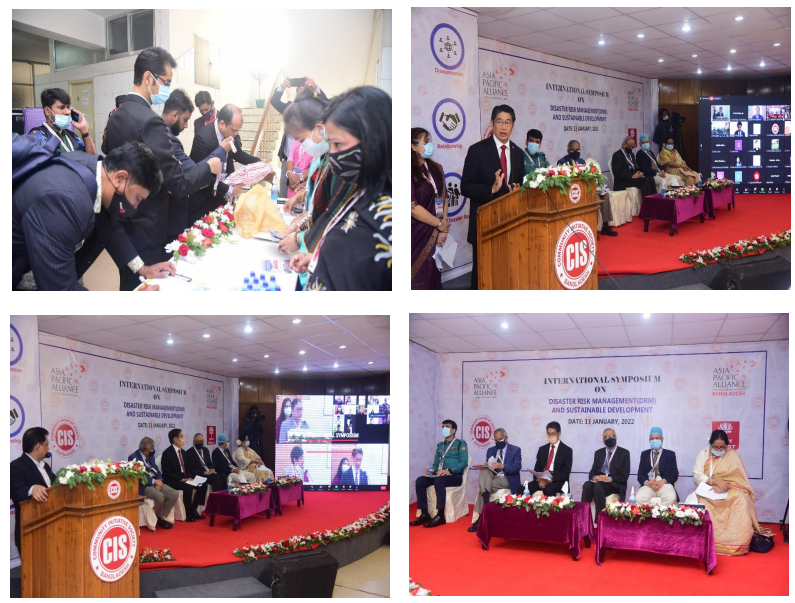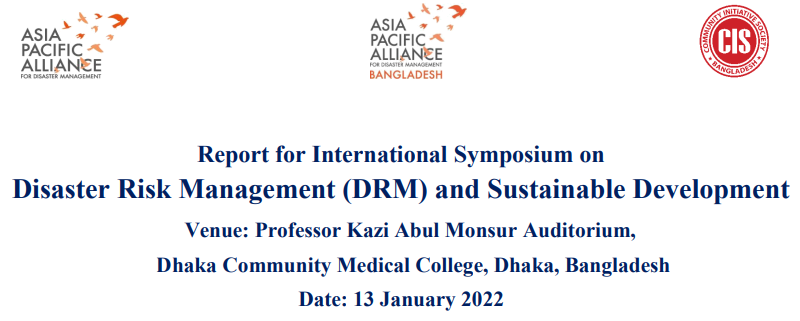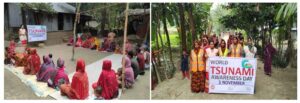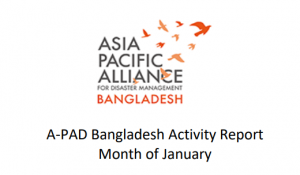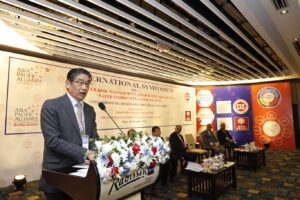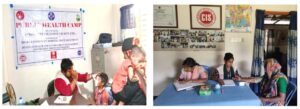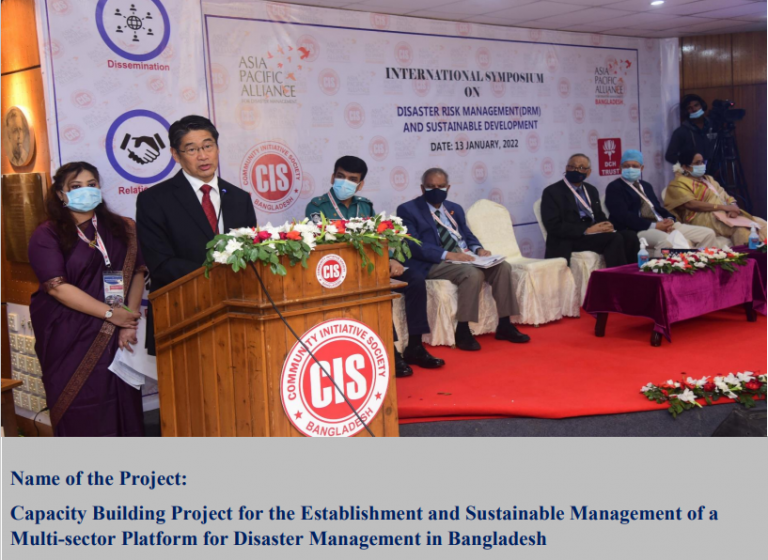
Background:
Bangladesh is a disaster-prone country of about 147,610 km2 with a population of about 160 million. The geographical setting and meteorological characteristics have made the country vulnerable to geo-hazards and hydro-meteorological disasters. The major disasters concerned in the country are floods, cyclones, droughts, tidal surges, tornadoes, nor‟-western, earthquakes, river erosion, fire, infrastructure collapse,
arsenic contamination of groundwater, waterlogging, water and soil salinity, cold wave, building collapse, epidemic and various forms of pollution, etc. Bangladesh is recognized as one of the most disaster-prone countries in the world and has been suffering from natural and manmade disasters. Three major seasons are generally recognized: a hot, muggy summer from March to June; a hot, humid, and rainy monsoon season from July to November; and a warm-hot, dry winter from December to February. The weather system is not always favorable. Due to this adverse weather system, Bangladesh becomes the worst victim of natural disasters like tropical cyclones, tidal bores, floods, tornados, riverbank erosion, earthquake, etc. occur in Bangladesh which causes loss of lives and properties. A large number of poor people are to live in vulnerable areas of the southern coastal belt of Bangladesh. The vulnerability is so deplorable or miserable that they have to go and settle in the newly accreted land in the Bay of Bengal and its surrounding areas which is frequently hit by a tidal surge or devastating cyclone. The adverse impacts of
all the natural hazards affecting socio-economic conditions need to be reduced for sustainable development. Realization of this reality, the Government of Bangladesh has undertaken a lot of plans and programs for disaster reduction through disaster management.
Goal of the Symposium:
Community Initiative Society (CIS) and Asia Pacific Alliance for Disaster Management (A-PAD) are jointly implementing a project on “Capacity Building Project for the Establishment and Sustainable Management of a Multi-sector Platform for Disaster Management in Bangladesh”. The goal of the Symposium is “To build up a partnership between two leading disaster management organizations
CIS and A-PAD are in a strong position to tap and establish Multi-sector Platform in this region.” These both are collaboratively organizing an International Symposium on “Disaster Risk Management (DRM) and Sustainable Development” in connection with the project, which will take place in Dhaka. This symposium will help to ensure comprehensive participation and support of NGOs, private organizations, business groups, and the Government for establishing a multi-sectorial platform. The main

Agenda of the symposium is to establish a Disaster Risk Reduction Network among various stakeholders, gathering knowledge, sharing information and experiences on disaster management strategies. The symposium will be conducted by following all COVID-19 safety measures instructed by the Government of Bangladesh.
Objectives:
Interactive networking and knowledge-sharing platform at the international level to identify and discuss the current disaster issues in a different context
To establish a Disaster Risk Reduction Network among various stakeholders, gathering knowledge and sharing information on disaster management strategies
To share experiences, good practices, lessons learned challenges, and solutions among National Platforms (international and local) on multi-sectorial collaboration, strengthening community resiliency, and effective humanitarian response.
Participants:
More than 200 participants from the A-PAD International and Local Platforms from member countries, Government, Universities, partners, NGO, School Teachers and private sector, Local Community from the seven divisions Dhaka, Rajshahi, Sylhet, Chattagram, Khulna, Rangpur, and Barisal representatives gathered in the Symposium. Symposium was held during the pandemic situation so that the international symposium was organized hybrid like two media: through zoom and physical. That’s why international participants joined the symposium through zoom.
Honorable Guest His Excellency Mr. ITO Naoki, Ambassador, Embassy of Japan to Bangladesh was the chief guest of the international symposium.
Mr. Kensuke Onishi, Chief Executive Officer, Asia Pacific Alliance for Disaster Management (A-PAD) was the special guest who joined virtually
Prof. Quazi Quamruzzaman, chairman of DCH Trust, CIS, and A-PAD was the chairperson of the international symposium.
Description:
The guests were arriving on the time. It was appreciated the Ambassador of Japan His Excellency Mr. ITO Naoki came to the program on time. Before entering the venue the Guests filled up the attendance sheet. The program was started with Bangladesh National Anthem in the morning. The inaugural session has also been held with the chair of guests, their introductory speech, and activities related to disaster management. Prof. Dr. Mahmuder Rahman, Trustee, Dhaka Community Hospital Trust gave warm welcome to everyone by his welcome address. He gave thanks to Mr. Kensuke Onishi , Chief Executive officer A-PAD has kindly made time to be joined us through Zoom and welcome Mr. ITO Naoki, Ambassador, Embassy of Japan, and all the participants who have been joined through zoom and physically. Bangladesh is a disaster-prone country. Disaster risk reduction (DRR) is an integral part of social and economic development and is essential if development is to be sustainable for the future. The relationship between sustainable development, disaster risk management, and climate change adaptation has not been treated in depth by many international institutions, national governments, and localities in the past 20 years.
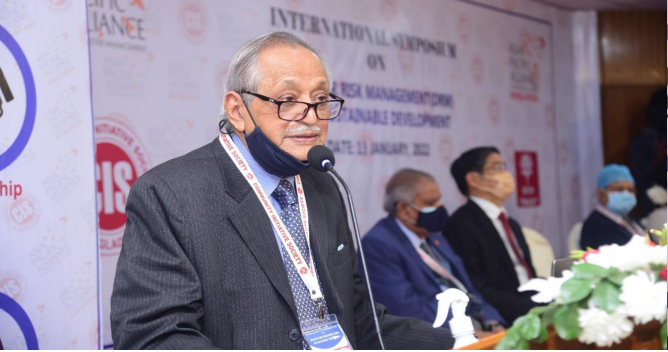
The adverse impacts of all the natural hazards affecting socio-economic conditions need to be reduced for sustainable development. The National Platform (NPF) of Disaster Management will help in participatory decision making in planning, resource sharing, and implementing disaster management policies more efficiently. Disaster management is a process of effectively preparing for and responding to disasters. It involves strategically organizing resources to lessen the harm that disasters cause. It also involves a systematic approach to managing the responsibilities of disaster prevention, preparedness, response, and recovery. Md.Golam Mostafa, Executive Director, CIS, gave some overview on CIS & A-PAD activity and future feasibility along with a video documentary of CIS response on disaster and emergencies. He mentioned Bangladesh is a highly affected region that affects not only people’s life but also the economy of the country. Disaster risk management is a must for the sustainable development of the country. Shahadat Hossain, Program Manager of CIS gave an overview and update of CIS and A-PAD Bangladesh activities. In that presentation, they shared all the activities done by CIS responses during the pandemic situation.

Mr. Kensuke Onishi, Chief Executive Officer gave thanks to the honorable guests who had joined the symposium. He gave thanks to the Ambassador of Japan His Excellency Mr. ITO Naoki, DG of Disaster Management Atiqil Huq, Joint Secretary Sabirul Islam, and all the staff. He highlighted the Capacity Building on Disaster Management. He also mentioned that Mitigation is the protection in Disaster is very important, prevention is important for vulnerable people, and response in emergency time involving civil society organizations. If the disaster becomes bigger rely on the system of logistics also depend on the military, coastguard, and transport companies. During the disaster is huge almost all things stopped and we are focused on our capacity and logistics which he was shoed through his video.

Prof. Dr. Saria Tasnim, Principle, Shaka Community Medical College Hospital shared her experience participating in different activities with CIS. A-PAD and A-PAD Bangladesh are working for disaster management in Bangladesh for a very long time nationally and internationally. Considering the regional vulnerability to natural and man-made disasters, ongoing Rohingya situation in Cox’s Bazar. CIS is strengthening its disaster-resilient intervention, vulnerable communities throughout the country on disaster preparedness, response, and mitigation. Sustainable development is the core approach of CIS. CIS doing multi-sectorial partnership GOVT. private sectors, local NGOs, and stakeholders to develop an effective network on disaster vulnerability. The collaboration of a multi-sectorial platform assesses efficient action planning of maximum level of impact on disaster management. CIS response on disaster and health response like community awareness, capacity building for local communities, different stage awareness, disaster emergency response, COVID-19 response strategic planning with multi-sectorial engagement climate change response activity and health facilities both rural and urban areas in Bangladesh. She also appreciated that CIS and A-PAD are working throughout the country with the grassroots vulnerable communities. A-PAD with all the country members supports the vulnerable community with aid support, alternative livelihood, and capacity development on climate resilience in the Asia Pacific region.
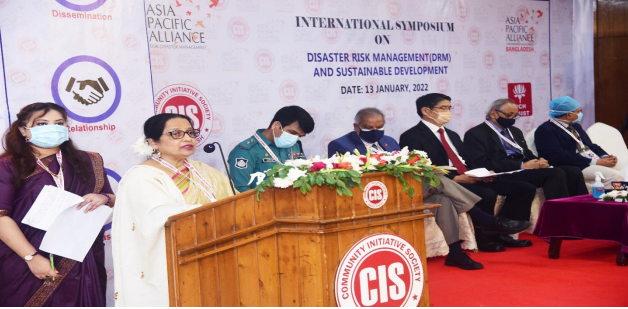
KM Ali Reza, Joint Secretary (Development), Ministry of Youth and Sports, GOB gave his valuable speech through zoom at the symposium. He mentioned that if it is possible to train one-third of people in disaster management. National youth policy also talks about beyond youth sacrifice of any kind of necessity on national needs and economic. We need to build awareness among youth about the achievement of sustainable development goals and motivate youth about the volunteer. He also focused few points regarding disaster management:
- Integrating environmental cost;
- Implementing a different plan to resilience the vulnerability and
- Remove water pollution.
Md. Saidul Islam, Deputy Police Commissioner, Dhaka Metropolitan Police, GOB was shared his experience about their activities during the pandemic situation. As the pandemic situation is an unknown fact to them as the police are the front liner from the beginning. He also mentioned that doctors are known about the COVID-19 case but the police are unknown about who is affected and who is not. But they are doing their duties properly and maintaining professionalism. He emphasized the different disaster phases like pre-disaster, during the disaster, and post-disaster situations. In all situations, Bangladesh Police continue their duty for saving a life

His Excellency Mr. ITO Naoki, Ambassador, Embassy of Japan to Bangladesh mentioned Bangladesh is a disaster-prone area where we need a different approach for disaster management and the importance of private sector collaboration. The strategic location will give an advantage to the country’s economic development. At the same time because of its geographical location, Bangladesh is suffering natural disasters like cyclones and floods. There are some similarities between Japan and Bangladesh like natural resources and disasters. For human life, nature is very important and for natural purposes, an important effort has to be taken on disaster management and disaster preparedness. Being one of the leading developing partners Japan is cooperating with Bangladesh on disaster preparedness, disaster warning, countermeasures on disaster management. In 2007 cyclone Sidr Japan supplied tents, blankets, and other necessary equipment as well as general assistance grant assessment through international organizations. In 2012 East japan faced an earthquake, Bangladesh supplied blankets through a mutual effort by the GOVT. civil society is the strong ties being knotted. The Japan GOVT. and JICA work collaboratively on implementing disaster preparedness build, back better. The idea was restored to the disaster-prone area about the pre-disaster state and rebuilt to be more resilient to disaster. The third united nation world conference on disaster risk reduction in 2015 at Sendai in Japan. Disaster management and humanitarian assistance are important pillars where it is talked about in the Asia pacific. In 2018 grant assistance for grass root activities provide support at the Rohingya Refugee camp. The exchange view on disaster response will help the vulnerable groups including the refugee camps in Cox’s Bazar. The symposium focuses on climate change and sustainable development and strengthens the community to improve disaster risk management.
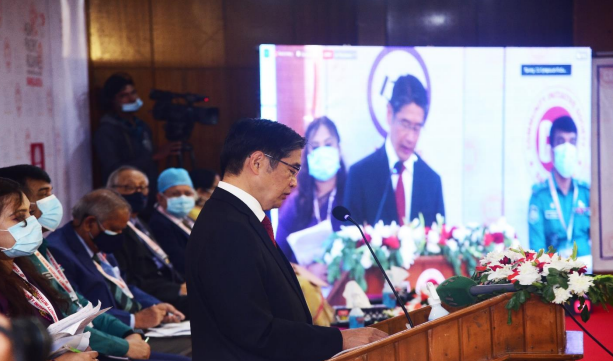
Prof. Quazi Quamruzzaman chairman DCH Trust, A-PAD, and CIS gave his valuable speech and thanked all the participants who had joined physically and through zoom. He gave special thanks to the Ambassador of Japan His Excellency Mr. ITO Naoki that he had joined the symposium from his busy schedule. He mentioned that in the last decade we have witnessed several magnitudes of disaster along with the COVID-19 pandemic and especially economic all the countries to sustainable development discussion is very important at the present context. As we know that disaster might be natural or man-made. Even natural disaster is triggered by human activities. For example, COVID-19 is still controversial that is it a natural or man-made disaster. Disaster is a nothing new concept as the world was started with the big bang is still a disaster. In our subcontinent, the Sindh civilization was disappeared because of the disaster. As human beings, we have to pass through the disaster and have to survive with it. Because of scientific development disaster characters have been changed so the resilience of management has to be always carefully planned. Asia Pacific region is the most disaster-affected area when there occur any disaster A-PAD was responding with the NGO from the past. Now A-PAD has a big partnership with NGO, GPVT. And the civil defense laws. He also discussed the strategies of big disasters like a cyclone. Bangladesh has established policies on disaster management. Bangladesh is developing a developed disaster management strategy. Dhaka is a highly densely populated and polluted city. According to the different contexts, there is a different disaster. CIS along with A-PAD doing collaboratively strategies on disaster management.
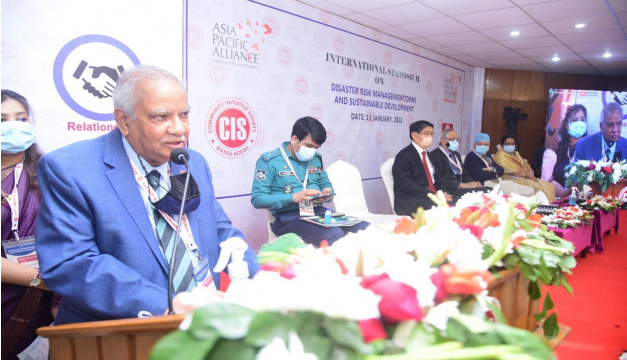
Panel Discussion: Session-1: Impact on Climate Change on Sustainable Development:
Session Moderator: Gawher Nayeem Wahre, Founder and Member Secretary, Disaster Forum Bangladesh.
Climate change does not yet feature prominently within the environmental or economic policy agendas of developing countries. Yet evidence shows that some of the most adverse effects of climate change will be in developing countries, where populations are most vulnerable and least likely to easily adapt to climate change, and that climate change will affect the potential for development in these countries. Some synergies already exist between climate change policies and the sustainable development agenda in developing countries, such as energy efficiency, renewable energy, transport, and sustainable land-use policies. Despite limited attention from policy-makers to date, climate change policies could have significant ancillary benefits for the local environment.
Md. Sayeedur Rahman, Management Counselor, Bangladesh Institute of Management, GoB
- DRM and sustainable development are multidimensional;
- Sustainable development depends on 5 things- People, Planet, Prosperity, Peace, and Partnership;
- The partnership between profit and politics are grained;
- Profit and politics are pushing out planet suffering which can be man-made and natural.
Masataka Uo, Director Strategic Planning, Networking, and Development, A-PAD
- Heavy rainfall increasing is the reason for climate change which affect our society;
- It is tough to identify the risk area regarding landslides;
- Challenges are used to prepare for the disaster, especially logistics support development;
- During the COVID-19 situation it was tough to reach the disaster-affected area;
- TCFD- need to disclose financial report how they prepare for climate change;
- Major companies planning to do a new thing regarding climate change and sustainable development.
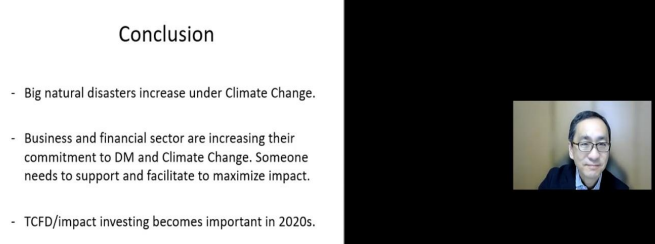
Jangwoo Lee, Director, Funding Strategies, A-PAD/ A-PAD Korea
- Shared best practice of collaboration in South Korea;
- Received donations from the private sectors;
- Private sectors are the front liners during the COVID-19 situation and work
collaboratively; - During the flood, it was damaged 180 US Doller and 20,000 people displaced
- Provide volunteers and nonfood items as the collaboration of A-PAD
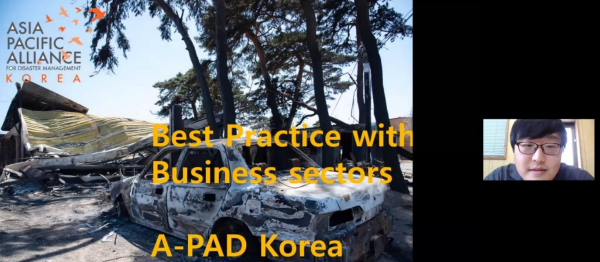
Sinta Kaniawati, Chairperson, A-PAD Indonesia, Director, A-PAD (Global partnerships)
- To be the most influential multisectoral hub of innovation;
- A transactional disaster aid alliance for saving more lives;
- The multisectoral hub of innovation and collaboration on disaster management;
- Community-based disaster resilience;
- 82% of companies have generally embedded into the sustainability plan;
- 2000 business innovation has been launched.
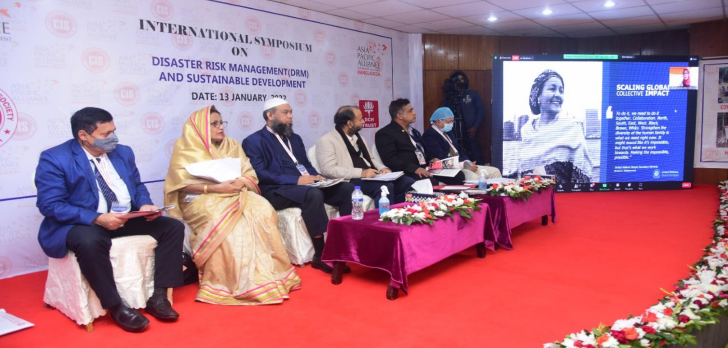
Prof. Dr. Abdul Kader Khan, Ex-Chairman, Examination Committee, Bangladesh
College of Physicians and Surgeons (BCPS), Bangladesh
- Impact of climate change effect all over the world;
- Population growth is the 1st cause;
- Deforestation is another cause for climate change;
- Industrializations and imitating huge carbon;
- Awareness program-People should understand the problem of climate change;
- Collaboration among the private sectors, GOVT. and international support.
Prof. Dr. Saria Tasnim, Principal, Dhaka Community Medical College Hospital
- Local carbon resources efficiency;
- Public and private investment asset;
- Use of domestic product and increase energy efficiency;
- SIDR and AMPHAN damaged lots of crops because of the salinity of the water;
- Manage liability and built resilience climate change addressing risk factors;
- Increasing community resilience to adapt to change;
- GOVT. and the private sector work collaboratively to build resilient on climate change;
- GOVT. and private sectors work collaboratively to built resilience on climate change;
- The green economy concept focused on the continuous attention on consumption and
intervention;
Prof. Abu Saleh Monirul Alam, Director, CRITOR
- Because of climate change, the season has been hampered;
- The river has been affected because of climate change and its effect;
- Man-made pollution affect climate change;
- To maintain the future generation we have to reserve the resources.
Dr. Md. Abduz Zaher, M.Phil (DU), Associate Professor, Institute of Nutrition and Food
Science, University of Dhaka
- Resilience comes from the public-private collaboration;
- Linking with the GOVT. and private sectors;
- Improving public, private partnership infrastructure, and land use;
- Community collaboration and leadership development on disaster management.
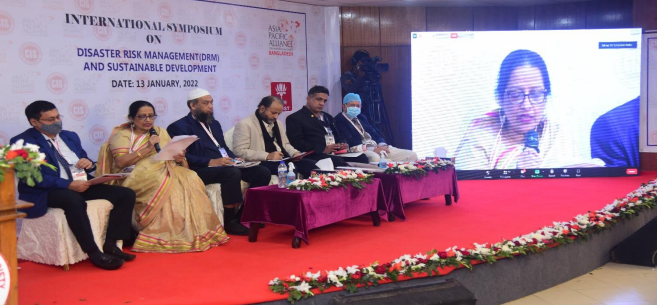
Panel Discussion: Session-2: STRENGTHENING COMMUNITY RESILIENCE
TO IMPROVE DISASTER RISK MANAGEMENT
Session Moderator: Dr. Md. Fuadul Islam, DRR Innovation Project Manager, DCH Trust While natural disasters cannot be controlled or avoided, there are ways to minimize their impact on society. A central key to risk reduction is building community resilience the ability of a community to work together to prepare for, cope with and recover from a disaster. Active personal preparedness and involvement in community risk mitigation programs are considered effective ways to improve local and national resilience. The first steps to successful public engagement are the dissemination and clarification of risks and a demonstration of the proper behavior during and following any disasters. Such engagement hopefully leads to informed, predictable, and productive behavior of readied individuals and emergency response teams.
Dato Dr Ahmad Faizal Mohd Perdaus, President, MERCY Malaysia
- To improve community resilience to achieving disaster risk management;
- We also have to educate the community on their translatable actions by increasing the
community’s ability and resilience in overcoming disaster; - We have to improve our knowledge and information dissemination, all levels to the
community in different media and the different way both practical as well as
information tools; - Early warning system can be done both better risk communication and better risk
information but doing more drills; - We have to remove the fear of to use of modern technology for early warning systems as
well as modern technology in hazards mapping, dissemination, information, and
evacuation center setup and movement of temporary shelter; - Involve all segment important players that are around the community in improving
community resilience; - We must have different approaches to different communities;
- It will not help to become community more resilient in the post-disaster also in
preparing a long-term resilient community towards facing disaster; - Post Disaster and post-crisis need assessment management include all economic, health,
education, shelter long-lasting mitigation resolution and solution for long term process.

Firzan Hashim, Country Director, A-PAD Sri Lanka, Chief Operating Officer (COO), A-PAD
- Built resilient community it has to confirm its locality itself;
- Built, back, better to build forward;
- Livelihood sustainability is extremely important to ensure sustainability
resilient to its continuous process; - We approach the right target audience to train sustainability and resilience
training; - We approach the right target audience to train sustainability and resilience
training; - Saving lives and property;
- Collaboration multisectoral approaches on sustainable resilience to ensure the
economy, health, and environment;
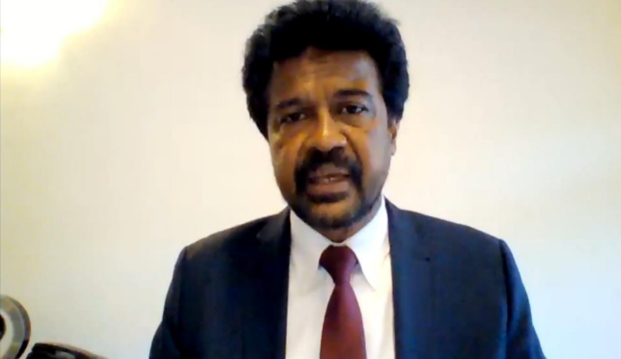
Nobutaka Miyahara, Senior Advisor, A-PAD
- Community association doing 3 things
- Open shelter and supplies food;
- Communication network, cities, office, and residence;
- Communicate with the GOVT. and make 5 years plan;
- Lack of flood management community getting poor,
- Professional disaster management committee enter into the residence and asking them
about the needs; - Community makes the partnership between GOVT. residence and other stakeholders;
- Disaster exhausted money and mind.

Mr. Gilbert Albero, Acting Board President, A-PAD Philippines
- During Typhoon 20 million families and 6 million families were affected;
- Communication is the key to resilience and engaging the community;
- Supported to the community by the A-PAD Philippines;
- Community is the key element in achieving citizenship to have to engage the
community; - We have strengthened the private sector;
- Local GOVT. play a big role in achieving resilience in the community;
- Specifying the capacities by designing resources and services.
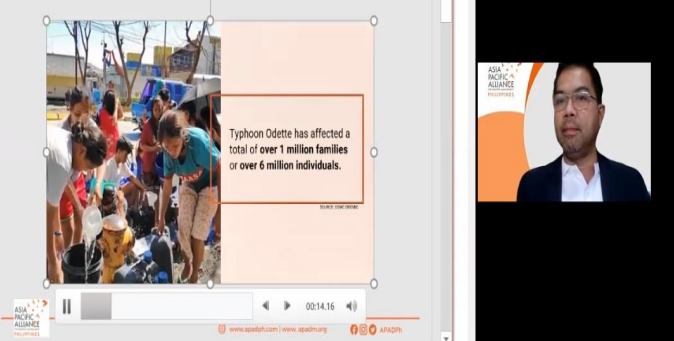
Dr. Md. Omar Sharif Ibne Hasan, Director, Associate Professor, Dhaka Community Medical
College and Hospital
- The impact of natural hazards and related environmental technical disaster;
- 3 parts of disaster risk reduction
- Prevention;
- Mitigation;
- Adaptation.
- To develop adaptation confirming building codes and develop the protection plan of the
coastal zone; - Recovery has 4 points
- Preparedness;
- Response;
- Recovery;
- Reconstruction.
- Bangladesh national plan for disaster management 2020-2025;
- Emergency hazards emergency response to attend to the requirements.
Prof. Dr. Dipak Kumar Mitra, Professor, and Chair, Public Health, North South University
- Standardize resilience measurement based on several frameworks;
- From unacademy point of view we are taking part in capacity building of the different
stakeholders; - There is a long course and half long course on public health;
- Global health and climate research in attitude from where we start;
- We have developed the capacity of our partner NGO.
Dr. Tanjina Chaklader, Assistant Professor, Dhaka Community Medical College
- The invention of modern technology and forecasting the disaster using social networks
and media; - Enlisted the support of various social groups promoting community partners;
- We have to be concerned about immediate emergency care according to the type of
disaster; - For public health to monitor and prevention of the epidemic, we must be vaccinated.
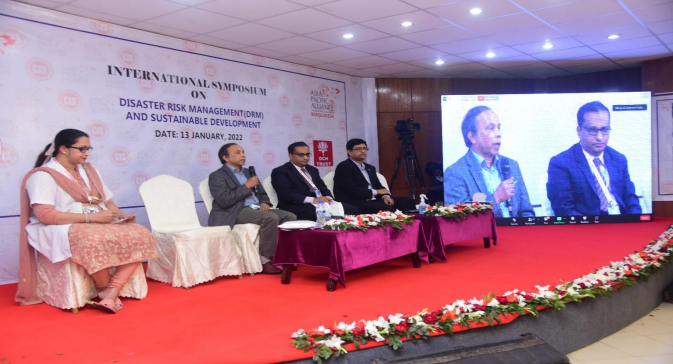
MOU Signing:
CIS signed MOU with the partners to work collaboratively in the future during and after the disaster. CIS signed MOU with 12 organizations from the 7 divisions. The main goal was to capacity building among the local partners.
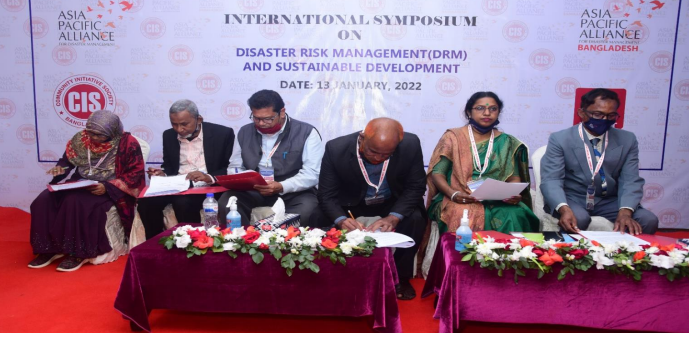
Feedback:
At the program, the participants gave their valuable feedback regarding the symposium, how they benefited, Participation of the conference, expert contribution what is the learning from the discussion and overall The usefulness of the conference.

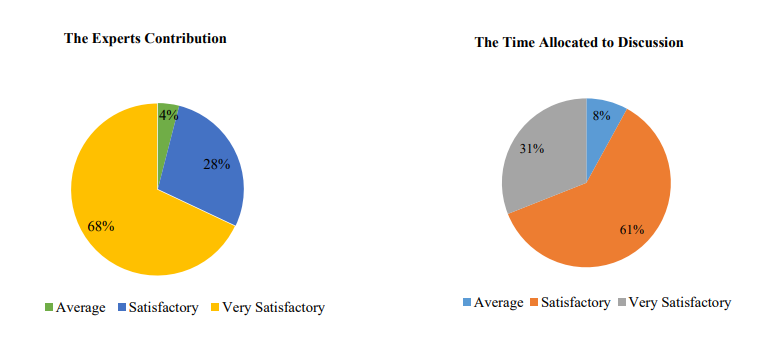
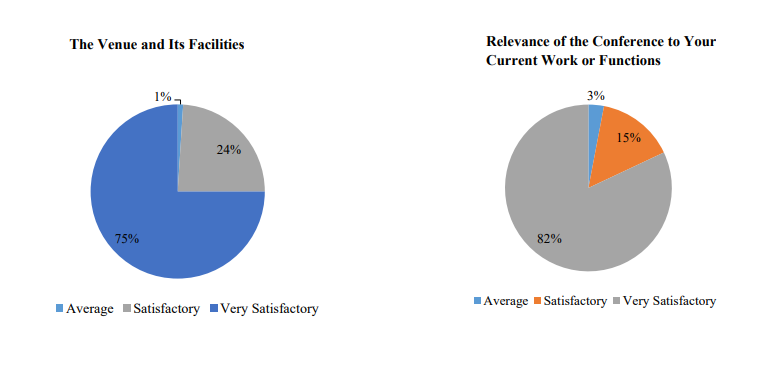
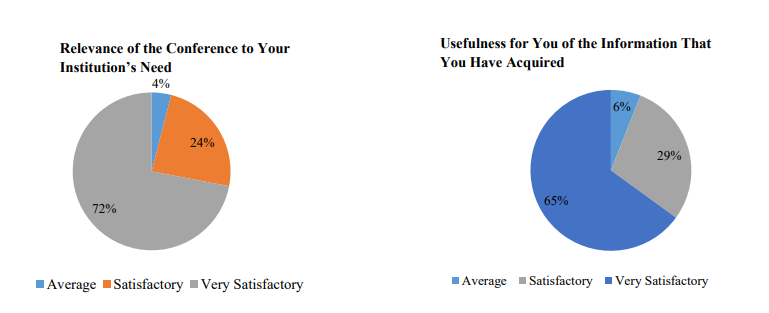
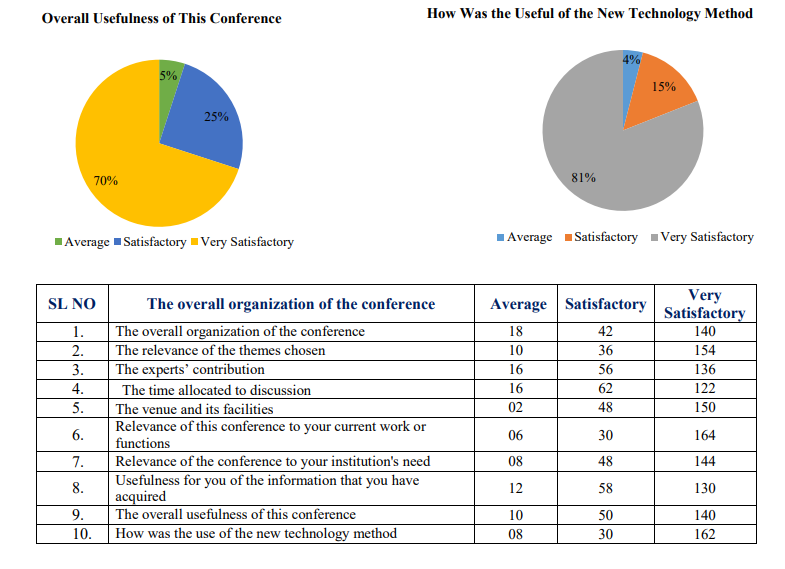
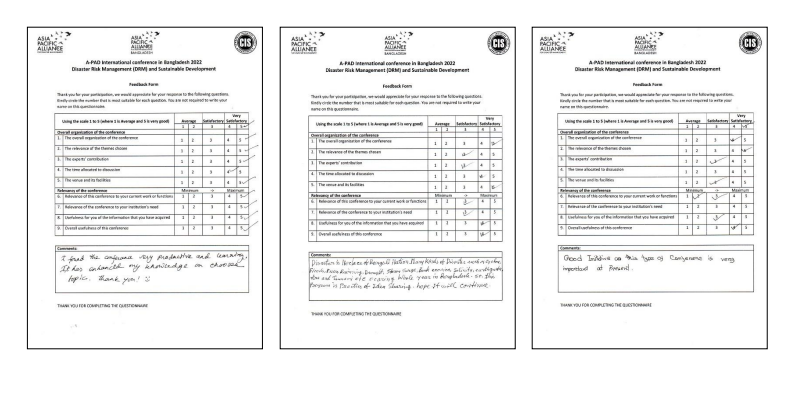
Recommendation:
Participants from the international symposium gave some recommendations about the program which is given below:
- Although the Symposium focused on climate change and sustainable development caused
by the participation of different sectors like GOVT. private sector and civil society, the
principles underlying these Recommendations apply to all disaster-related activities. - Local infrastructure and logistics for disaster preparedness, including resources and
funding - Disaster preparedness planning for all phases of a disaster including risk assessment with
concern for vulnerable populations. - Development of evidence-based technical guidance and training programs for the
advancement of disaster risk management capabilities - Partnership: It helps the organization to build a resilient relationship with the conference
attendees by analyzing their valuable feedback and engaging with them to make the next
conference better.
Conclusion:
Prof. Quazi Quamruzzaman, Chairman, A-PAD, CIS, and DCH Trust closed the International Symposium with his closing remarks with giving thanks to all guests from the A-PAD International and Local Platforms from member countries, Government, Universities, partners, staff, and other participants. Community Initiative Society and A-PAD Bangladesh collaboratively organized the International Symposium at Dhaka Community Medical College Auditorium on 13 January 2022. There are more than 200 participants including different NGOs, INGOs, Government, Medical personnel, private organizations, and stakeholders joined this program physically and virtually. A lot of discussions about disaster risk management and what are the role of the community, private sector, and civil society in the new normal age. After the program, CIS and A-PAD Bangladesh contact MOU with 12 organizations so that the organizations work collaboratively during and after a disaster.
